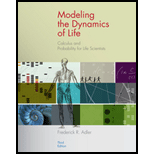
Concept explainers
(a)
To find the population of bacteria after
(a)
Answer to Problem 57E
Therefore, the population after
The population after
The population after
Explanation of Solution
Given information:
Calculation:
Suppose a population of bacteria with the initial condition
However,
Now, the population after
Therefore, the population after
Now, the population after
The population after
Again, the population after
The population after
(b)
To find how many bacteria were harvested based on the given data.
(b)
Answer to Problem 57E
Explanation of Solution
Given information:
Calculation:
Since there are three harvests of
Hence, the total number of bacteria that were harvested is
(c)
To write the discrete-time dynamical system using the obtained values
(c)
Answer to Problem 57E
Explanation of Solution
Given information:
Calculation:
As the population of bacteria doubles every hour and
(d)
To find how many bacteria could be removedin the population
(d)
Answer to Problem 57E
There would be
Explanation of Solution
Given information:
Calculation:
Now, ifwe wish to harvest bacteria until the end of
Hence, there would be
So, we can harvest
Again, the bacteria removed early never had a chance to reproduce.
Want to see more full solutions like this?
Chapter 1 Solutions
Modeling the Dynamics of Life: Calculus and Probability for Life Scientists
 Algebra & Trigonometry with Analytic GeometryAlgebraISBN:9781133382119Author:SwokowskiPublisher:Cengage
Algebra & Trigonometry with Analytic GeometryAlgebraISBN:9781133382119Author:SwokowskiPublisher:Cengage

